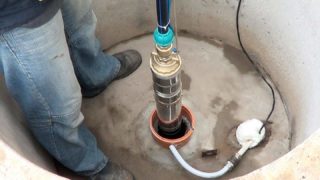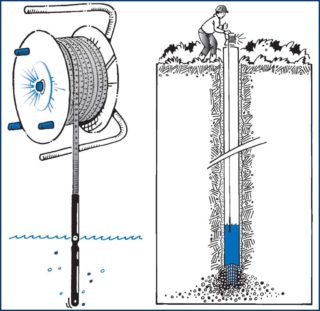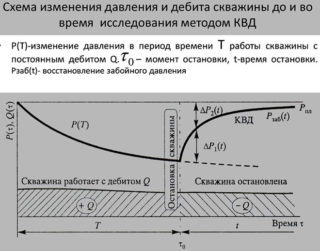An autonomous water supply system has been built in most country houses where the central network is not installed. To provide themselves with an uninterrupted supply of usable water for many years, homeowners decide to drill an artesian well. Its advantages lie in a large flow rate and a long operating period, but to raise water from great depths, powerful submersible pumps are required.
Why is it important to correctly determine the depth of lowering the pump into the well

Installing a pump in a well is not as difficult as it might seem at first glance. The main task is to first familiarize yourself with all the requirements for the installation of water equipment.
For efficient and uninterrupted operation of an autonomous water supply system, it is important to select and install equipment correctly. If we are talking about an artesian well with a water reservoir depth of more than 30-40 meters, you will need to purchase an expensive submersible pump. In comparison with their counterparts, they have the greatest power and performance.
The technical characteristics of the unit must correspond to the characteristics of the well. Accurate determination of the pump sinking depth into the well will save money on the purchase. The more powerful the equipment, the higher its cost. Also, equipment with a properly selected power will serve much longer than one that is idle or overheats due to the inability to provide the optimal pressure of the water column.
Depth determination methods

It is possible to calculate the depth of immersion of a water pump in a well using practical and mathematical methods. In order to save money, specialists use the following method:
- A nylon cord or a strong steel cable with a polyethylene braid is tied to the equipment.
- Downhole equipment is lowered to the maximum permissible depth.
- As soon as the pump touches the bottom, it is lifted approximately 2 meters. This distance will be sufficient to position the device in the middle of the aquifer.
- The cable is fixed to the soil surface. As a rule, a log or a cover is used, which will hermetically close the well shaft.
- A test run is carried out to check the functionality.
If the quality and purity of the water remains consistently clean, the power and performance of the device does not decrease, you can fix the cord and close the shaft.
It is advisable to use this method if the depth of the aquifer is not more than 15 meters. If we are talking about wells with a depth of 50-60 meters or more, it is impossible to resort to the mechanical method. Shafts with such a depth are drilled after calculations and obtaining permission to carry out work, therefore, information on the maximum permissible depth of the pump in the well shaft should already be available.
Well dynamic response method

To calculate the optimal immersion depth of a deep-well pump, it is recommended to take the dynamic characteristic as a basis. This value reflects the distance between the surface of the water mirror, into which the aquifer is lowered, and the surface of the soil.In this case, the water level is calculated with the equipment turned on and during the period with the maximum water consumption (as a rule, these are summer months).
It is easier to calculate the optimal depth if the static level and flow rate of the source are also indicated in the technical data sheet of the well.
The flow rate of the source is its productivity: how much water it can replenish per unit of time. If the power of the submersible pump exceeds the flow rate of the well, the latter will eventually simply dry out.
There are many supporters of both bottom-hole installation of a deep well pump and its installation at the top of the casing. Each of these types has advantages and disadvantages, so you should carefully read them before making a decision. It is also advisable to take into account the standard tips and tricks:
- When buying a submersible pump, it is important to analyze and compare the performance of the equipment with the debit of the source.
- Before proceeding with the installation of the water unit, it is important to familiarize yourself with its technical and operational characteristics.
- It is recommended not to put the equipment on the bottom of the well, as it will quickly become clogged with silt, sand and small algae. It is better to install the device on a special pallet, which will protect it from blocking the pipeline and will have a good effect on the quality of well water.
- If a submersible pump is required to be installed above the water surface, it is recommended to additionally equip the well with a “dry running” sensor - a float, which will ensure timely switching on and off of equipment depending on the water level in the well, or immediately purchase modifications equipped with special sensors.
A correctly calculated immersion depth of the pump in the well will have a beneficial effect on the quality of the water and the operating life of the entire water supply system.
When buying, it is better to refrain from vibration-type models, which adversely affect the condition of the casing, and also raise all solid particles, algae and other debris from the bottom.
Depth limits for electric pump placement
The dynamic level is calculated with the water pump turned on. The value is equal to the interval between the water surface and the soil surface. The dynamic level is fixed at the equilibrium point of the pumped out and newly arriving flow.
The submersible (deep) pump must be located below the dynamic value threshold by at least 1 - 3 meters. This is the main condition that must be observed, otherwise the electric pump may flood, which will cause serious damage.
If the equipment is installed in a sand hole, make sure that the system is equipped with cleaning filters. The pump is mounted at a height of at least 0.5 meters from the bottom. An increased concentration of sand, silt and other solid impurities can clog the parts of the electric pump and disable it. With this installation, it is important to regularly service the system and carry out preventive cleaning.
It is recommended to purchase equipment for an autonomous water supply system in large specialized stores or from official representatives of manufacturing companies.









